Question based on Jain Solved Assignment and other course
Answer:
In making investment decisions, cost of different types of capital is measured and compared. The source, which is the cheapest is chosen and than capital is raised. It is necessary to determine the specific cost of each source in order to determine the minimum obligation on a company. (Generally, the following are the sources of capital:
Specific cost of different sources of raising funds are calculated In the following manner :
Cost of Debt Capital
Funds can be borrowed both for short term as well as for long term. Short term debt is required to satisfy working capital needs. The cost of debt finance can be defined in terms of the required rate of return that the debt financed investment must yield to prevent damage to the stockholders position. The cost of debt can be computed in the following manner:
- Cost of Short Term Debt: Short term funds are borrowed for short period of time and repaid within the operating period. Cost of short term debt is the percentage of burden in relation to net proceeds of the debt. In this context, burden can be defined as the annual rate of interest accepted to be paid plus other related costs. When funds are borrowed, some expenses such as brokerage, stamps duty, legal expenses etc. are to be incurred by borrower. So, it is necessary to compute cost of debt on net proceeds.
- Cost of Long Term Debt: According to Weston and Brigham, “The cost of debt is defined as the rate of return that must be earned on debt financed investment in order to keep unchanged the earning available to equity shareholders”. Long term debts include bonds, debentures, bank loan, term loan, public deposits etc. Acompany must earn minimum return on debt capital to protect the interest of shareholders. For example. A company issues 12% debentures for Rs. 10 lakhs at par. It must earn at least Rs. 1,20,000 p.a. to protect the interest of shareholders. If company earns less than Rs. 1,20,000, the return to shareholders will be affected adversely and the market value, of share will also decrease.
Cost of Debentures or Bonds: A company borrows capital in order to maximize the profits for its shareholders i.e., to pay higher dividend to them. It continues to use this source of finance untilthe incremental return is higher than the incremental cost of debt capital.
According to Sec. 2(12) of the Indian Companies Act, 1956 the term debenture includes debenture stock, bonds and any other securities of a company whether constituting a charge on assets of the company 01 not Interest is paid to the debenture holders at a fixed rate. The interest on debentures is payable even if the company does not earn the profits.
Debentures or Bonds can be issued at par, at premium or at discount. When debentures or bonds are issued, a company has to incur some issue expenses such as underwriting commission, printing and other expenses, brokerage etc. These expenses are deducted from issue price while computing net proceeds. Debentures can be classified into two categories :
- Irredeemable Debentures: These are also known as perpetual debentures. Irredeemable debentures are those whose principal is not repaid to the debenture holders by the company during its life time.
Computation of Cost of Debentures
- When Debentures or Bonds Issued at Par: If debentures or bonds are issued at par, the cost of debentures or bonds will be :
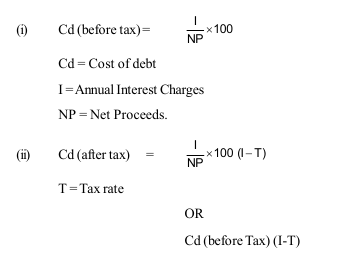
- When Debentures or Bonds are Issued at Premium or Discount: In case the debentures or bonds are issued at premium or discount, the cost of debt should be calculated on the basis of net proceeds realized on account of issue of such debentures or bonds.
- It should be noted that interest is always calculated on face value (Paid up) of debentures.
- Net proceeds should be calculated as follows :
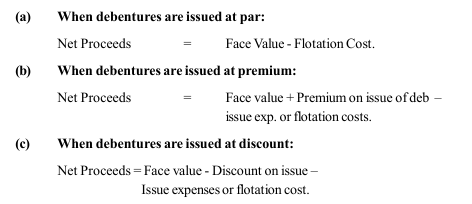
- In the absence of information brokerage, underwriting commission etc. may be calculated on face value of debentures.
- Cost of Redeemable Debt: Redeemable debentures provide for the payment of the principal amount on the expiry of a certain period. Generally, these debentures are redeemed at par or at premium. If the redeemable debentures are issued by the company, the cost of debentures can be computed by using the following formula:

Cd = Cost of debt
I = Annual interest charges
RV = Redeemable value or price NP = Net proceeds
n = Number of years of maturity
Tax Adjustment: When tax payable is computed, the interest paid on debt is deducted from income. The higher the interest charges, the lower will be the amount of tax payable by the firm, the cost of debt after tax will be calculated as follows :

Cost of Preference Share Capital
Preference shares are the fixed cost bearing securities. A fixed rate of dividend is payable on preference shares. Although, payment of dividend on preference shares is not compulsory but it is generally paid whenever the company makes sufficient profits. Preference shares can be divided into two parts for the purpose of computation of cost of capital (i) Irredeemable Preference shares (ii) Redeemable Preference Shares.
- Cost of Irredeemable Preference Share Capital: Irredeemable preference shares can be redeemed only when company goes into liquidation, According to the Companies (Amendment) Act, 1988, no company can issue irredeemable preference shares or shares which are redeemable after 10 years from the date of their issue. The cost of irredeemable preference share capital is calculated as follows :

Tax Adjustment: It should be noted that preference share dividend is paid out of after tax profits. Hence, the cost of preference share capital is not adjusted for taxes. The cost of preference share capital is automatically computed on after tax basis. If we want to calculate cost of capital before tax, the following formula should be used :

- Cost of Redeemable Preference Share Capital: Redeemable preference shares are those shares which can be redeemed on maturity date. The cost of redeemable preference share capital can be calculated as follows :

Cp = Cost of redeemable preference share capital. n = No. of years in which shares are to be redeemed RV = Redeemable value or Maturity value
NP = Net Proceeds
DPS = Dividend Per Preference Share.
Cost of Equity Share Capital
Cost of equity share capital is the minimum rate of return that the company must earn on equity financed portion of its investments in order to leave unchanged the market price of its stock. It is sometime argued that equity share capital is free of cost. It is, because, it is not legally binding for company to pay dividends to ordinary shareholders. However, this is not true. In fact, the equity shareholders invest their funds in shares with the expectation of getting dividend from the company. Thus, equity shares involve a return in terms of dividend expected by the equity shareholders.
Methods of Computing Cost of Equity Share Capital:
The following methods are used for computing cost of equity share capital :
- Dividend Yield Method
- Earnings Yield Method
- Dividend Yield and Growth in Dividend Method
- Realized Yield Method.
- Dividend Yield Method: It is also known as dividend price ratio method. According to this method, the cost of equity share capital is calculated on the basis of a required rate of return interms of future dividends to be paid on equity shares for maintaining their present market price. This method is based on the assumptions that the investors give prime importance to dividends and risk in the form remains unchanged. This method does not seemto consider the growth in dividend. The following formula is used for computation of cost of existing equity shares :
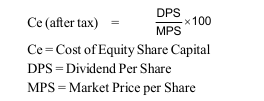
- Earnings Yield Method: This is also called ‘Earnings Price Ratio’ method. According to this approach, the earning per share determines the market price of equity shares. Under this method, the cost of equity share capital is equal to the rate which must be earned on incremental issues of equity shares so as to maintain the present value of investment. The following formula is used for computation of cost of equity share capital:
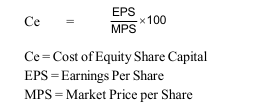
This method of computing cost of equity capital may be employed in the following cases :
- When the earnings per share are expected to remain constant.
- When all earnings are distributed to the shareholders in the form of dividends.
- The market price of the share is influenced only by earnings per share.
- Dividend Yield and Growth in Dividend Method: According to this method, the cost of equity is determined on the basis of the expected dividend rate plus the rate of growth in dividend. The rate of growth in dividend is determined on the basis of amount of dividends paid by the company for the last few years. According to this approach the cost of equity share capital may be determined by using the following formula :
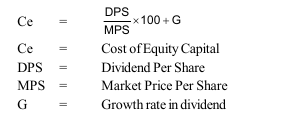
- Realised Yield Method: According to this method, the rate of return actually realised by shareholders forms the basis for determining the cost of equity capital. The advocate of this approach argue that the rate of earnings as well as the market price of shares are always subject to fluctuations on account of so many factors. Therefore the return actually realised is a true indicator of the return expected by the shareholders. The realised return is discounted al the present value factor and then compared with the value of investment. This approach is based on the following assumptions :
- The risks of the company remain same.
- The shareholders continue to expect the same rate of return for bearing the given risk.
- The reinvestment opportunity rate of the shareholders is equal to the realised yield.
- Cost of Newly Issued Equity Shares: When new equity shares are issued by the company, it has to incur some expenses such as underwriting commission, brokerage, printing and other expenses. These expenses are deducted from the issue price or market price (If it is given) and net proceeds is computed. The cost of equity capital is computed on the basis of net proceeds and dividend per share and earnings per share.
The following formulae are used to compute the cost of equity capital:
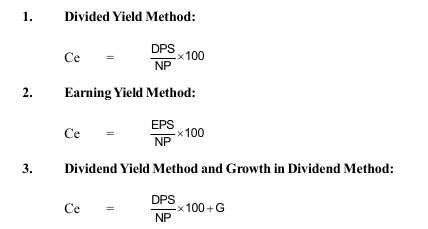
Cost of Retained Earnings
Retained earnings are the profits which have hot been distributed by the company to its shareholders and have been retained in the company to be used for future expansion. They are represented by the uncommitted or free reserves and surplus. Retained earnings do not involve any cash cost or out of pocket cost. Therefore, some people argue that retained earnings are cost free. However, it is not true, Retained earnings involve an opportunity cost. From shareholder’s point of view, the opportunity cost of retained earnings is the rate of return that they can obtain by Investing after tax dividend in the similar securities, if earnings are paid to thorn as dividend in cash. The following adjustments are made while computing cost of retained earnings.
- Income Tax: An individual pays income tax on dividend hence he would only be able to invest the amount remained after paying individual income lax on such earnings. Similarly, an individual also pays tax on capital gain. Hence, adjustment of income tax is made.
- Brokerage, Commission etc.: When the amount of dividend is invested, some expenses like brokerage commission etc. are incurred by the investor. These expenses are deducted from invested amount.
The following formulae may be used for computation of cost of retained earnings:
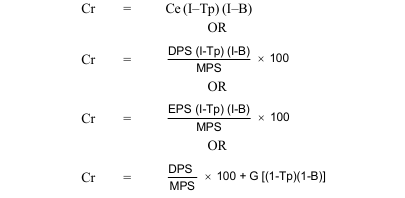

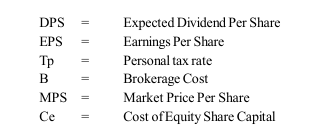
Adjustment of Tax on Capital Gain: When a shareholder has to pay income tax on capital gain, the following formula should be used while computing cost of retained earnings :
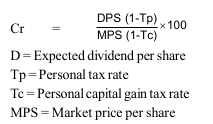
Adjustment of Tax on Capital Gain: When a shareholder has to pay income tax on capital gain, the following formula should be used while computing cost of retained earnings :

D = Expected dividend per share
Tp = Personal tax rate
Tc = Personal capital gain tax rate
MPS = Market price per share
Total Views: 18
